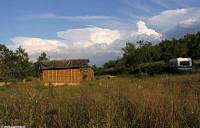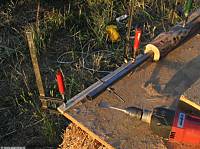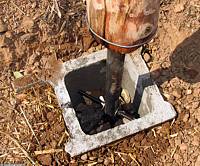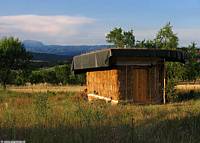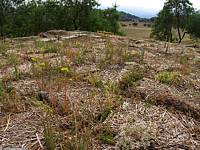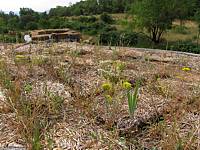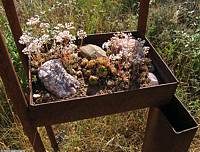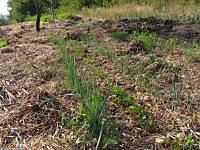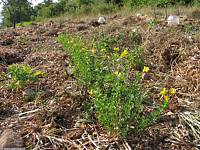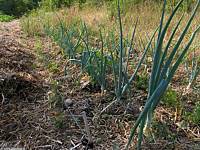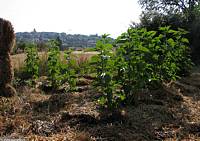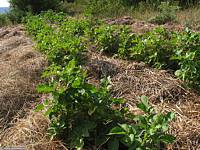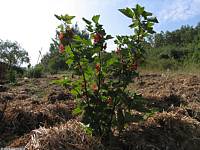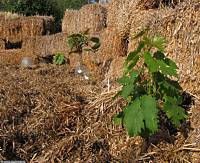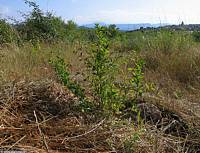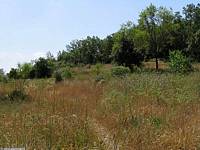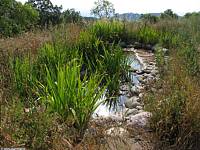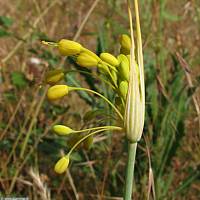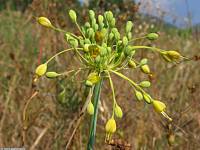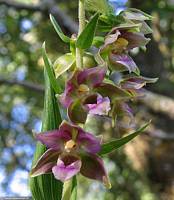|
|
Nature
Switched On
|
|
|
introduction |
2009 June 19 to26, Friday to Friday
One month ago we
straightened the garden house with a hoist, and it was now time to
take away the cables, hoist and temp
|
An upcoming thunderstorm which would bring a welcome 3 litres
of rain. |
|
|
||
| The
construction of the anchorage. To assure a perfect centering and
verticality, guides and clams were used. 22 June 21:02 |
||
| The post
anchored inside a cement block in the ground.
The metal wire helps to avoid the splitting of the trunk. 23 June 11:23 |
The post in position, with the
trunk 12 cm above ground level. 25 June 20:15 |
|
|
Of course I will have to monitor dimensions and angles of walls and roof, to see if the situation really stays stable. I may have to add another post or perhaps take away some heavy stones from the roof.
The vegetation on the roof is promising. Maintenance is limited to
No better illustration of the resistance of Sedum species than this mini garden in a piece of iron trash. The plants have to endure the occasional flooding as well as extreme dry-out in summer.
|
Flowering Sedum
album (white) and Sedum reflexum (yellow)
on the green roof. |
|
|
The green roof, looking south. 20 June 9:48 |
||
| Flowering
Sedum anglicum and Sempervivum tectorum
in a mini iron-rock garden. 26 June 9:41 |
||
|
In the vegetable garden I try to 'switch nature on' by two
main features: straw and green fertilizers. Straw suppresses
undesirable weeds, stimulates soil life and
retains humidity; the green fertilizers must provide nutrients.
Results have been quite mixed so
|
||
|
Two rows of Leek (Allium porum) and in between a
row of Trifolium repens (White clover) as a green
fertilizer. 24 June 9:08 |
||
|
A row of yellow flowering, nitrogen-fixing Lotus
corniculatus in a bed of heavily predated cabbage. 24 June 9:04 |
Respectively a row of Trifolium
repens, onions, carrots and onions. 24 June 9:09 |
|
|
But some vegetables and fruit shrubs really seem to love straw.
The potato plants are a joy for the eye. No digging, no weeding, no
watering. We have already harvested 4 small potatoes that tasted
delicious.
|
||
|
The heavily mulched potatoes. At the front the early Jaerla and a the back the later Red Pontiac. 24 June 9:10 |
Another tubercle: Jerusalem
artichoke (Helianthus tuberosus). Forms a nice hedge
in mid summer and flowers beautifully in late summer. 24 June 9:12 |
|
|
Vine (Merlot) with a Kiwi in the centre. |
Red currant, that will probably
need some netting against birds. 24 June 9:07 |
|
|
I applied flakes of straw to many planted species on the terrain
|
||
|
Berberis vulgaris
with a mulch of straw flakes on the lower northern terrace. Looking north-east. 26 June 9:37 |
||
|
The terrain is slowly turning yellow and brown, with the exception of the pond with its fresh green lining of water plants. But water is transpiring very fast there and I pumped up some water from the inferior pond, where the water level is much higher due to the absence of transpiring plants. |
||
|
Overview of the centre of the terrain. Scabiosa columbaria flowering on the right. Looking south. 25 June 11:49 |
The partially filled up superior
pond. Looking south-east. 24 June 9:41 |
|
|
Allium flavum (Yellow onion) is
the last bulb to flower in the sequence of the planted bulbs. All
five planted bulbs have started to bloom. It is supposed to be
native for the Pyrenees (although not mentioned by the 'Herbario
de Jaca') and grows on dry, sunny places.
The last orchid to flower is probably this Epipactis species (Helleborine) , which is flowering relatively abundantly in the wood border. |
The opening of the
inflorescence of Allium flavum. |
|
|
Allium flavum in
the bulb area. 20 June 10:12 |
||
|
Epipactis microphylla (or E. helleborine?)
in the shade of the wood border on the higher terrace. 21 June 9:27 |
||
|
introduction
|
|
